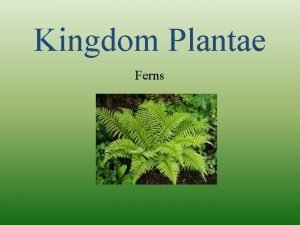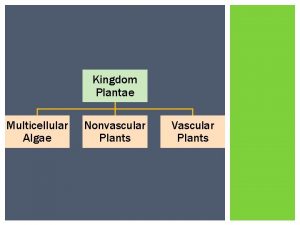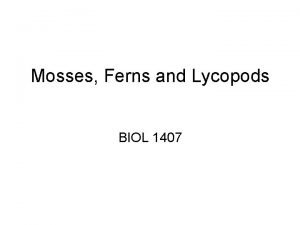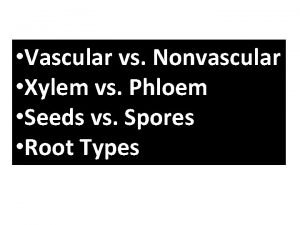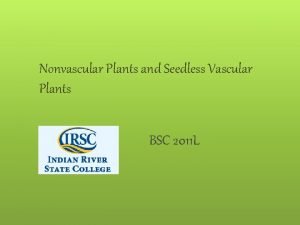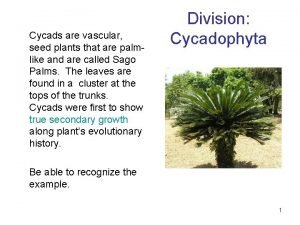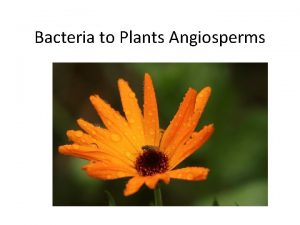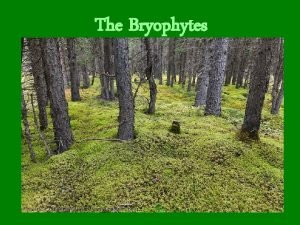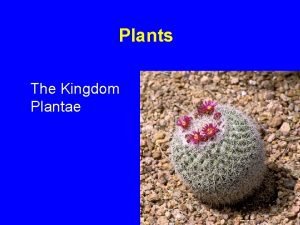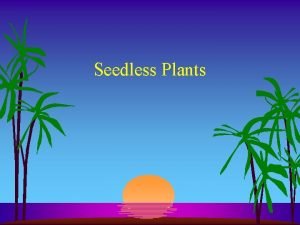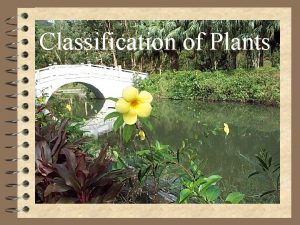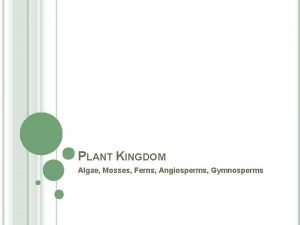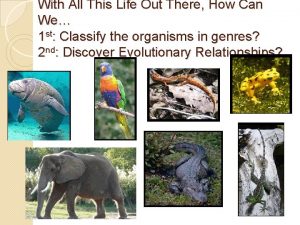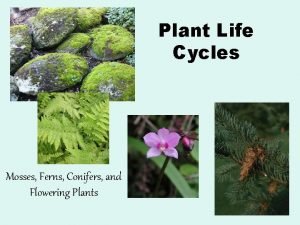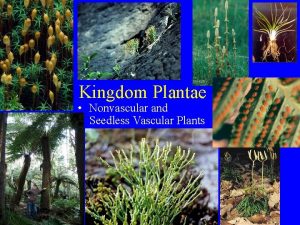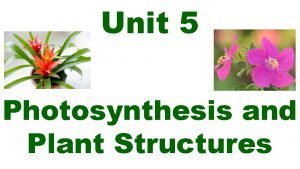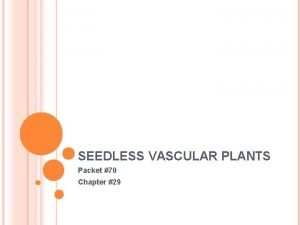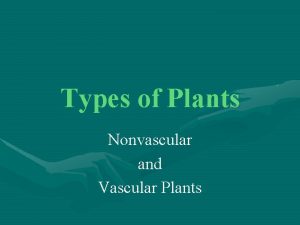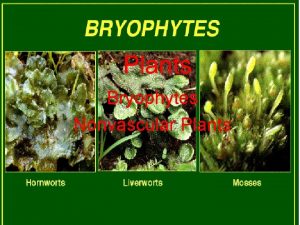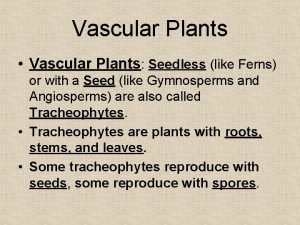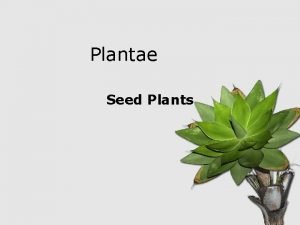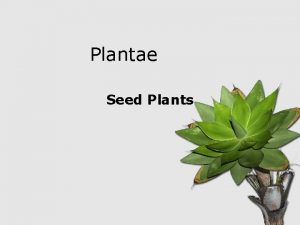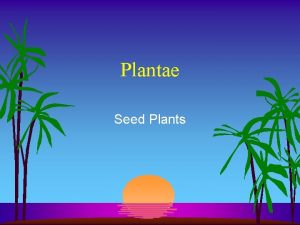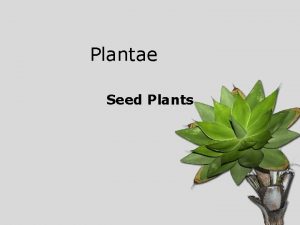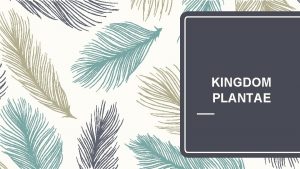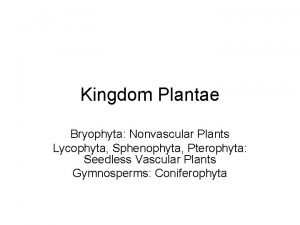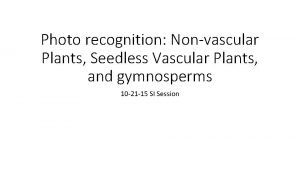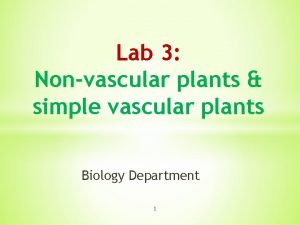Kingdom Plantae Ferns KINGDOM PLANTAE Vascular Plants Nonvascular





























- Slides: 29

Kingdom Plantae Ferns

KINGDOM PLANTAE Vascular Plants Non-vascular Plants Phylum Tracheophyta Phylum Bryophyta Seeds No Seeds Ferns Mosses

What do we know so far about plants?

Moss Summary

The Pteridophytes (fern family) probably evolved from an algae around the same time as the bryophytes were evolving. RHYNIA: 400 RHYNIA million years ago The 1 st vascular plant.

What Does “Vascular” Mean? • Xylem – water moves up xylem from roots to tip • Phloem – sugar (made in leaves) and moves down sinks

Transpiration • Transpiration is the movement of water from root to tip of plant • Occurs due to cohesive nature of water • Evaporation causes water to constantly leave the leaves of all plants

• Sink cell is a root • Source cell is a leaf • Translocation is the movement of sugar in plants • Transpiration is the movement of water in plants

Leaf Cross Section

Ferns – the REPTILES of Kingdom Plantae • Ferns are still tied to the water for reproduction • motile sperm • No true roots or conducting tissue to bring in water • Koru = fiddlehead (young fern)

Spore Production in Ferns

Fern Advances 1. Sporophyte stage of the lifecycle becomes dominant. 2. Separate Gametophyte prothallus for sexual reproduction 3. Well developed tissues: can grow bigger 4. Adapted to warm wet climate

Fern Life Cycle

2. Sub-Phylum Sphenophyta (equisitem) Reproductive structure

Vegetative structure




Sub-Phylum Pterophyta (ferns) 1. This is the most diverse group with over 12, 000 species 2. Their lived 400 million years ago, and the ferns we see today first appeared 300 million years ago. 3. Their leaves are called FRONDS and begin as fiddleheads which ‘unfurl’ (unroll) as the leaves mature. Fiddleheads can be eaten, but many species are toxic. 4. The roots are simple RHIZOMES 5. The sporangia are located on the underside of the leave in circular clusters called SORUS (sori). Sometimes the sori are covered by a small leaf growth called INDUSIUM.

FERN PROTHALLUS (gametophyte)

eggs sperm

FERN PROTHALLUS with SPOROPHYTE

FERN FIDDLEHEAD (‘baby’ sporophyte) http: //www. youtube. com/watch? v=Xru. TNNab. Ue 0&feature=related

HOW DO WE USE FERNS? Trim the base of your ferns, leaving only a tiny tail beyond the circumference of each Fiddlehead. Rub off any remaining furry brown covering. Rinse under running water. Drop ferns into a large pot of boiling salted water. Boil for about 5 minutes or until tender. If undercooked, you will miss the full, rich flavor. Drain well and serve piping hot with melted butter.

http: //www. youtube. com/watch? v=-x. F 83 p. HEx 6 Q FERN FRONDS WITH SORI

Fern plant cells Sporangia Indusium

INDUSIUM

SORI RELEASE SPORES

ECOLOGICAL ROLE OF FERNS • Pioneer species: first to establish themselves in areas with poor soil (little nutrients) • Once the ferns are established, they improve living conditions for other species 1. Put nutrients back into the soil 2. Help prevent erosion Ultimately, they set the stage for their own demise, as other plants and trees will come in a take over.
 Fern kingdom
Fern kingdom Plantae multicellular
Plantae multicellular Nonvascular plants
Nonvascular plants Nonvascular plant diagram
Nonvascular plant diagram Vascular and nonvascular plants
Vascular and nonvascular plants Lycopods
Lycopods Seed vs spore
Seed vs spore Non vascular plant
Non vascular plant Psilotum
Psilotum Cycads: vascular tissue
Cycads: vascular tissue Is a gerber daisy vascular or nonvascular
Is a gerber daisy vascular or nonvascular Coniferophyta vascular or nonvascular
Coniferophyta vascular or nonvascular Nutritional habits for hypnum sp
Nutritional habits for hypnum sp Common characteristics of plantae
Common characteristics of plantae Multicellular dependent embryos
Multicellular dependent embryos Seedless vascular
Seedless vascular Vascular and non vascular difference
Vascular and non vascular difference Share
Share Kingdom protista
Kingdom protista Protista mobility
Protista mobility Ferns and algae kingdom
Ferns and algae kingdom Cladogram of five indoor plants
Cladogram of five indoor plants Is conifers a flowering plant
Is conifers a flowering plant Youtube
Youtube Capital of egypt during the old kingdom
Capital of egypt during the old kingdom Old kingdom middle kingdom new kingdom
Old kingdom middle kingdom new kingdom Nnn ruled
Nnn ruled Seedless vascular plants phylum
Seedless vascular plants phylum What is a node on a plant
What is a node on a plant Seedless vascular plants phylum
Seedless vascular plants phylum
